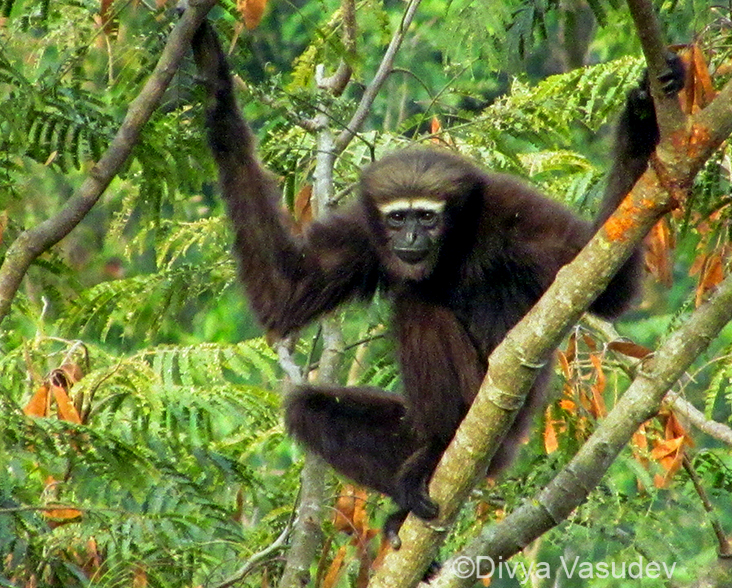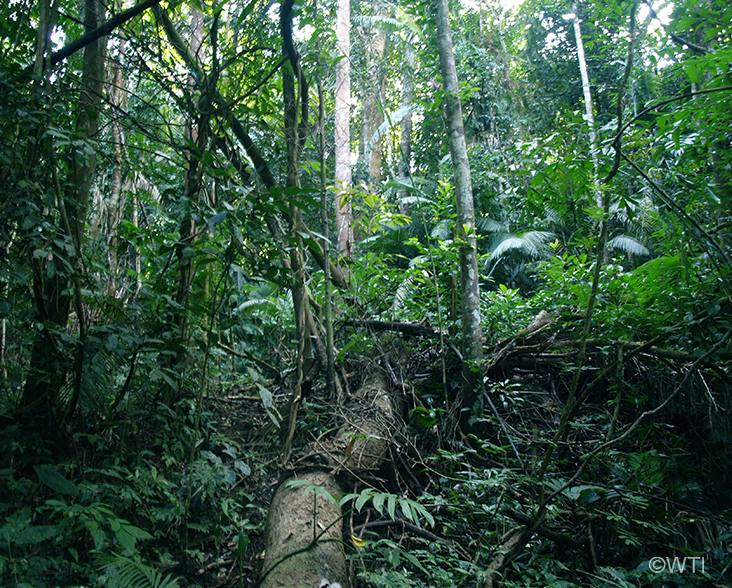WESTERN HOOLOCK GIBBON
Species Data
Class: Mammalia
Order: Primates
Family: Hylobatidae
Scientific Name: Hoolock hoolock
IUCN Red List status: Endangered
Description
The Western Hoolock Gibbon is an ape found in the tropical forest canopy in India, Bangladesh and Myanmar.
Tailless like other apes, they are nonetheless set apart by their long arms and dense hair. Males are black with a tell-tale white eyebrow-like stripe above their eyes and weigh around 6.9kg. Females are much lighter in colour, usually a shade of beige, brown, grey or yellow, and weigh around 6kg.
The loud and musical calls of Western Hoolock Gibbons can be heard from far away in the forest. Males and females often sing in unison, a series of duet calls that helps the pair to mark their territory. Male-female vocalisations are alike – a circumstance that sets them apart from other gibbon species – and tend to feature alternating high and low notes that ring rapidly, accelerating with every call.
Behaviour
These gibbons are arboreal and only come to the ground in exceptional circumstances. You’ll find them leaping, climbing and jumping through the tree canopy where they feed, sunbathe, rest, forage, play, groom and call. They are omnivorous, consuming over 100 species of plants and some invertebrates and birds’ eggs, with a diet that can greatly vary based on location.
Western Hoolock Gibbons form small, monogamous family groups and usually give birth to a single offspring. Babies typically spend their first months of life tightly clung around the mother’s waist, followed by gradual weaning over two years. The young gibbon will then stay with his parents until sexual maturity.


Habitat
Healthy forests are critical to the survival of Western Hoolock Gibbons as they rely entirely on uninterrupted canopy. Within its already restricted range – this species is only present in a triangle spanning the northeast of India and Bangladesh and the west and north of Myanmar – this ape is found in a range of forest types, from moist deciduous to evergreen, sub-tropical to lowland. However, their optimal habitat remains an undisturbed canopy of tall trees with thick undergrowth.
Threats and Conservation
Western Hoolock Gibbon are one of Asia’s most endangered primates, with populations expected by the IUCN to at least halve over three generations (2001-2015, 2016-2030 and 2031-2045). Threats such as hunting for food and medicine and habitat loss have put this species at risk, and habitat protection is critical for their survival.
At a time when Western Hoolock Gibbon habitats are being deforested all across Asia, World Land Trust supporters are making a difference. Since 2003, donations to us have allowed our partner Wildlife Trust of India to protect and expand biodiversity corridors used by these gibbons in the Garo Hills of Meghalaya State and starting in 2022, we’ll be funding the protection of tens of thousands more acres to expand the network.
Protected by these WLT Projects
References
Lwin, N., Sukumal, N. & Savini, T. (2021). Modelling the conservation status of the threatened hoolock gibbon (genus Hoolock) over its range. Global Ecology and Conservation, 29. doi:10.1016/j.gecco.2021.e01726
